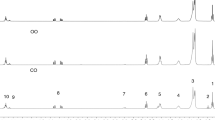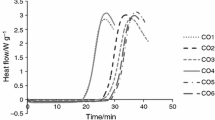Abstract
Chia (Salvia hispanica L.) seed oil is the richest natural source of α-linolenic acid, an n − 3 polyunsaturated fatty acid (ω-3 PUFA), contributing to its use as functional and nutraceutical food in large part of Latin America. However, a food with such fatty acid composition could be highly susceptible to lipid oxidation. Thus, the present study was conducted to determine the thermal and oxidative stability of chia oil by various methods. Rancimat method was used to evaluate the effect of synthetic and natural antioxidants in the oxidative stability. Pressurized differential scanning calorimetry (PDSC), Schaal test and 1H NMR spectroscopy were used to assess the thermal stability. The effect of frying temperature and/or heating time on fatty acid composition was assessed by 1H NMR. The results show that tert-butylhydroquinone (TBHQ) and a mixture of TBHQ and rosemary extract were effective in increasing the oxidative stability of chia oil. Concerning the storage conditions, PDSC, Schaal test and 1H NMR data showed that chia oil is stable at 60 °C; hence, there is no need for special storage conditions. PDSC and 1H NMR results indicate that chia oil cannot be used in cooking and frying, because at high temperatures severe degradation of the unsaturated groups and loss of the nutritional properties of the oil occur.





Similar content being viewed by others

References
Theriault A, Chao J, Wang Q, Gapor A, Adellik K. Tocotrienol: a review of its therapeutic potential. Clin Biochem. 1999;32:309–19.
Saldeen K, Saldeen T. Importance of tocopherol beyond α-tocopherol: evidence from animal and human studies. Nutr Res. 2005;25:877–89.
Shahidi F, Wanasundara UN. Omega-3 fatty acid concentrates: nutritional aspects and production of technologies. Trends Food Sci Technol. 1998;9:230–40.
Boran G, Karacam H, Boran M. Changes in the quality of fish oils due to storage temperature and time. Food Chem. 2006;98:693–8.
Kolanowski W. Seasonal variability in intake of fish oil dietary supplements among inhabitants of Warsaw. Nutr Res. 2008;28:245–50.
Baum SJ, Kris-Etherton PM, Willett WC, Lichtenstein AH, Rudel L, Maki KC, et al. Fatty acids in cardiovascular health and disease: a comprehensive update. J Clin Lipid. 2012;6:216–34.
Burr M, Gilbert I, Rogers S, Holliday RM, Sweemam PM, Elwood PC, Deadman NM. Effects of changes in fat, fish and fibre intake on death and myocardial reinfarction. Diet and Reinfarctional trial (DART). Lancet. 1989;334:757–61.
Connor W. α-Linolenic acid in health and disease. Am J Clin Nutr. 1999;69(5):827–8.
WHO/FAO. Fats and oils in human nutrition. FAO. 1994.
Ayerza R, Coates W. Composition of chia (Salvia hispanica) grown in six tropical and subtropical ecosystems of South America. Trop Sci. 2004;44:131–5.
Ayerza R. Oil content and fat acid composition of chia (Salvia hispanica L.), from five northeastern locations in northwestern Argentina. J Am Oil Chem Soc. 1995;72:1079–81.
Ixtaina VY, Martínez ML, Spotorno V, Mateo CM, Maestri DM, Diehl BWK, Nolasco SM, Tomas MC. Characterization of chia seed oils obtained by pressing and solvent extraction. J Food Comp Anal. 2011;24(2):166–74.
Shahidi F, Zhong Y. Lipid oxidation and improving the oxidative stability. Chem Soc Rev. 2010;39:4067–79.
Smouse TH. Factors affecting oil quality and stability. In: Warner K, Eskin NAM. Methods to assess quality and stability of oils and fat—containing foods. Champaign, IL, AOCS, 1995.
Dobarganes MC, Velasco J. Analysis of lipid hydroperoxides. Eur J Lipid Sci Technol. 2002;104:420–8.
Frankel EN. In search of better methods to evaluate natural antioxidants and oxidative stability in food lipids. Trends Food Sci Technol. 1993;4(7):220–5.
AOCS, Official Methods and Recommended Practices of the American Oil Chemists’ Society: fats, oils and lipid related analytical methods. Champaign, USA, 6ed. AOCS Press, 2009.
Akoh C. Oxidative stability of fat substitutes and vegetable oils by the oxidative stability index method. J Am Oil Chem Soc. 1994;71(2):211–6.
Levy P. Pressure differential scanning calorimetry. Thermochim Acta. 1970;1:429–39.
Kodali DR. Oxidative stability measurement of high-stability oils by pressure differential scanning calorimeter (PDSC). J Agric Food Chem. 2005;53(20):7649–53.
Dunn RO. Oxidative stability of biodiesel by dynamic mode pressurized-differential scanning calorimetry (PDSC). Am Soc Agric Biol Eng. 2006;49(5):1633–41.
Sacchi R, Falcigno L, Paduano A, Ambrosino ML, De Giulio B, Addeo F, Paolillo L. Quantitative evaluation of the aldehydes formed in heated vegetable oils using high resolution proton-NMR spectroscopy. Riv Ital Sostanze Gr. 2006;83:257–63.
Tyl EC, Brecker L, Wagner KH. 1H NMR spectroscopy as tool to follow changes in the fatty acids of fish oils. Eur J Lipid Sci Technol. 2008;110:141–8.
Guillén DM, Ruiz A. Monitoring of heat—induced degradation of edibles oils by proton NMR. Eur J Lipid Sci Technol. 2008;110:52–60.
Guillén MD, Uriarte PS. Monitoring by 1H nuclear magnetic resonance of the changes in the composition of virgin linseed oil heated at frying temperature. Comparison with the evolution of other edible oils. Food Control. 2012;28:59–68.
Kirby CW, McCallum JL, Fofana BA. 1H NMR study of the fatty acid distribution in developing flax bolls before and after a cooking treatment. Can J Chem. 2011;89:1138–42.
American Oil Chemist’s Society Official Method Cd-12b-92. Am oil Chem Soc Champaign IL, 1993.
Nascimento JA, Araujo KLGV, Epaminondas PS, Pontes ALS, Souza AL, Queiroz N, Souza AG. Ethanolics extracts of Moringa: antioxidant effect in soybean oil by PDSC and Rancimat. J Therm Anal Calorim. 2014;117:265–8.
Fennema OR. Principles of food science, part i, food chemistry. New York: Marcel Dekker Inc; 1976.
Andrade DF, Mazzei JL, Kaiser CR, d’Avila LA. Assessment of different measurement methods using 1H-NMR data for the analysis of the transesterification of vegetable oils. J Am Oil Chem Soc. 2012;89:619–30.
Ayerza R, Coates W. Protein content, oil content and fatty acid profiles as potential criteria to determine the origin of commercially grown chia (Salvia hispanica L.). Ind Crop Prod. 2011;34:1366–71.
Ixtaina VY, Nolasco SM, Tomás MC. Oxidative Stability of Chia (Salvia hispanica L.) Seed Oil: effect of Antioxidants and Storage Conditions. J Am Oil Chem Soc. 2012;89:1077–90.
Tuberoso C, Kowalczyk A, Sarritzu E, Cabras P. Determination of antioxidant compounds and antioxidant activity in commercial oilseed for food use. Food Chem. 2007;103:1494–501.
Ganesan B, Brothersen C, McMahon DJ. Fortification of foods with omega-3 polyunsaturated fatty acids. Crit Rev Food Sci Nutr. 2014;54:98–114.
Halliwell B, Aeschbach R, Löliger J, Aruoma OI. The characterization of antioxidants. Food Chem Toxicol. 1995;33(7):601–17.
Ramalho VC, Jorge N. Antioxidants used in oils, fats and fats food. Quim Nova. 2006;29(4):755–60.
Holda K, Glogowski R. Selected quality properties of lipid fraction and oxidative stability of dry dog foods under typical storage conditions. J Therm Anal Calorim. 2016;126:91–6.
Cordeiro AMTM, Medeiros ML, Santos NA, Soledade LEB, Pontes LFBL, Souza AL, Queiroz N, Souza AG. Rosemary (Rosmarinus officinalis L.) extract: thermal study and evaluation of the antioxidant effect on vegetable oils. J Therm Anal Calorim. 2013;113:889–95.
We N, Selke E, Mounts TL, Rinsch W, Frankel EN, Zeiton M. Effect of triacylglycerol composition and structures on oxidative stability of oils from selected soybean germplasm. J Am Oil Chem Soc. 1992;69:111–8.
Acknowledgements
The authors acknowledge The Brazilian agencies Conselho Nacional de Desenvolvimento Científico e Tecnológico (CNPq) for the financial support.
Author information
Authors and Affiliations
Corresponding authors
Rights and permissions
About this article
Cite this article
Souza, A.L., Martínez, F.P., Ferreira, S.B. et al. A complete evaluation of thermal and oxidative stability of chia oil. J Therm Anal Calorim 130, 1307–1315 (2017). https://doi.org/10.1007/s10973-017-6106-x
Received:
Accepted:
Published:
Issue Date:
DOI: https://doi.org/10.1007/s10973-017-6106-x



